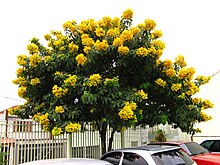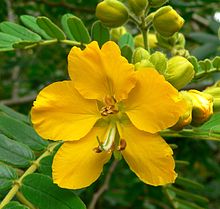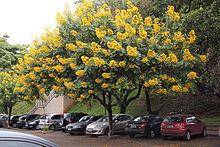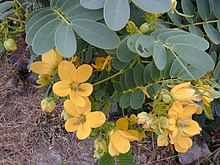Senna (plant)
| Senna | |
|---|---|

| |
| Senna alexandrina | |
| Scientific classification | |
| Kingdom: | Plantae |
| Clade: | Tracheophytes |
| Clade: | Angiosperms |
| Clade: | Eudicots |
| Clade: | Rosids |
| Order: | Fabales |
| Family: | Fabaceae |
| Subfamily: | Caesalpinioideae |
| Tribe: | Cassieae |
| Genus: | Senna Mill. |
| Type species | |
| Senna alexandrina | |
| Species | |
|
Over 300; see text | |
| Synonyms[1] | |
|
show
List | |
Senna, the sennas, is a large genus of flowering plants in the legume family (Fabaceae, subfamily Caesalpinioideae,[2] tribe Cassieae). This diverse genus is native throughout the tropics, with a small number of species in temperate regions. The number of species is estimated to be from about 260[3] to 350.[4] The type species for the genus is Senna alexandrina. About 50 species of Senna are known in cultivation.[5]
Description[]
Senna includes herbs, shrubs, and trees. The leaves are pinnate with opposite paired leaflets. The inflorescences are racemes at the ends of branches or emerging from the leaf axils. The flower has five sepals and five usually yellow petals. There are ten straight stamens. The stamens may be different sizes, and some are staminodes. The fruit is a legume pod containing several seeds.[6]
Systematics[]
Chamaecrista, Cassia, and Senna form a monophyletic group which some authors have called Cassia sensu lato.[7] In 1982, the group was named Cassiinae and classified as a subtribe of the tribe Cassieae.[8] The tribe Cassieae contains 21 genera and is now known to be polyphyletic,[7] but the classification is still accepted because a revision of Fabaceae has yet to be published.[7]
The genus Senna has had a complex taxonomic history.[9] What is now known as Senna was included by Linnaeus in his concept of Cassia in Species Plantarum in 1753.[10] Philip Miller segregated Senna from Cassia in 1754 in the fourth edition of The Gardeners Dictionary.[11] Until 1982, many authors, following Linnaeus, did not recognize Senna and Chamaecrista, but included them in a broadly circumscribed Cassia sensu lato. Phylogenetic analyses of DNA have shown that Chamaecrista, Cassia, and Senna are all monophyletic, but the relationships between these three genera have not been resolved.[3] They are therefore shown in phylogenetic trees as a tritomy.
Etymology[]
The genus name derives from the Arabic sanā, describing plants whose leaves and pods have catharitic and laxative properties.[12]
Species[]
As of December 2019, Plants of the World Online accepted the following species:[13][14][15]
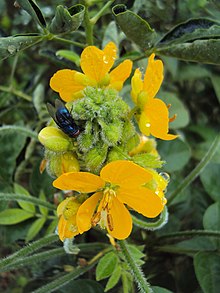


- (Griseb.) H.S.Irwin & Barneby
- Senna acclinis (F.Muell.) Randell
- (Benth. ex A.Gray) Randell
- (Pohl ex Benth.) H.S.Irwin & Barneby
- (Borhidi) A.Barreto & Yakovlev
- H.S.Irwin & Barneby
- (Benth.) H.S.Irwin & Barneby
- (Benth.) H.S.Irwin & Barneby
- (Benth.) H.S.Irwin & Barneby
- Senna alata (L.) Roxb. – candlebush, Christmas candle
- Senna alexandrina Mill. – Alexandrian senna
- (Benth.) H.S.Irwin & Barneby
- (Vogel) H.S.Irwin & Barneby
- (Lam.) H.S.Irwin & Barneby
- Du Puy & R.Rabev.
- (Capuron) Du Puy
- (Cav.) H.S.Irwin & Barneby
- (M.Martens & Galeotti) H.S.Irwin & Barneby
- (Vogel) Wiersema
- (H.S.Irwin & Barneby) H.S.Irwin & Barneby
- H.S.Irwin & Barneby
- (Kunth) H.S.Irwin & Barneby
- (Rose) H.S.Irwin & Barneby
- H.S.Irwin & Barneby
- Senna armata (S.Watson) H.S.Irwin & Barneby
- (Hook.) H.S.Irwin & Barneby
- Senna artemisioides (Gaudich. ex DC.) Randell – grey cassia, leafless cassia, woody cassia
- (L.) H.S.Irwin & Barneby
- (Ruiz & Pav. ex G.Don) H.S.Irwin & Barneby
- Senna auriculata (L.) Roxb. – avaram, Matara-tea, tanner's cassia
- (Herb.) H.S.Irwin & Barneby
- H.S.Irwin & Barneby
- (Chiov.) Lock
- (L.f.) H.S.Irwin & Barneby – West Indian showertree
- (Sweet) Randell
- Lass. – pepper-leaf senna, smooth senna, yellow peabush
- (Colla) Hewson
- (A.Gray) H.S.Irwin & Barneby
- (Britton & P.Wilson) H.S.Irwin & Barneby
- Senna bicapsularis (L.) Roxb. – rambling senna, Christmas bush, money bush, yellow candlewood
- A.O.Araujo & V.C.Souza
- (Dombey ex Vogel) H.S.Irwin & Barneby
- Du Puy & R.Rabev.
- D.B.O.S.Cardoso & L.P.Queiroz
- (Gaudich.) H.S.Irwin & Barneby
- (Villa) H.S.Irwin & Barneby
- H.S.Irwin & Barneby
- (Nees & Mart.) H.S.Irwin & Barneby
- (Vogel) H.S.Irwin & Barneby
- (F.Muell.) Randell
- (Harms) L.P.Queiroz
- Senna caudata (Standl.) H.S.Irwin & Barneby
- Afr.Fern.
- H.S.Irwin & Barneby
- (Balb.) H.S.Irwin & Barneby
- (Isely) A.Barreto & Yakovlev
- (Symon) Randell
- (Harms) H.S.Irwin & Barneby
- (Desv.) H.S.Irwin & Barneby
- (W.Fitzg.) Randell
- (Domin) Randell
- (Britton) H.S.Irwin & Barneby
- M.Nee & Barneby
- H.S.Irwin & Barneby
- (Greene) H.S.Irwin & Barneby
- (Benth.) H.S.Irwin & Barneby
- H.S.Irwin & Barneby
- (Benth.) Randell
- Senna corymbosa (Lam.) H.S.Irwin & Barneby – Argentine senna, Argentine wild sensitive plant[16]
- (J.F.Bailey & C.T.White) Randell
- Senna covesii (A.Gray) H.S.Irwin & Barneby – Coues' cassia, Coves' cassia, desert senna[16]
- (Benth.) H.S.Irwin & Barneby
- (Kunth) H.S.Irwin & Barneby
- (Hook.) H.S.Irwin & Barneby
- H.S.Irwin & Barneby
- (Hook. & Arn.) H.S.Irwin & Barneby
- (J.M.Black) Randell
- (J.F.Macbr.) H.S.Irwin & Barneby
- (F.Muell.) Randell
- Afr.Fern. & P.Bezerra
- (Britton & Rose) H.S.Irwin & Barneby
- (V.Singh) V.Singh
- (Rose) H.S.Irwin & Barneby
- Senna didymobotrya (Fresen.) H.S.Irwin & Barneby – candelabra-tree, peanut butter cassia, African senna
- (Nees & Blume) Lock
- Senna domingensis (Spreng.) H.S.Irwin & Barneby
- (Rose) H.S.Irwin & Barneby
- (Brenan) Lock
- (Symon) Randell
- (Randell) Randell
- (Ruiz & Pav. ex G.Don) H.S.Irwin & Barneby
- H.S.Irwin & Barneby
- (Mill.) H.S.Irwin & Barneby
- (M.Martens) H.S.Irwin & Barneby
- (Benth.) H.S.Irwin & Barneby
- (Craib) H.S.Irwin & Barneby
- Senna gaudichaudii (Hook. & Arn.) H.S.Irwin & Barneby – climbing cassia, heuhiuhi (Pacific Islands, Queensland)[17]
- H.S.Irwin & Barneby
- (H.St.John) A.C.Sm.
- (Randell) Randell
- (DC.) Randell
- (A.Cunn. ex Benth.) Randell
- (Baker f.) Lock
- (Donn.Sm.) H.S.Irwin & Barneby
- (Urb.) H.S.Irwin & Barneby
- (Symon) Randell
- H.S.Irwin & Barneby
- (J.F.Macbr.) H.S.Irwin & Barneby
- (Britton & Rose) H.S.Irwin & Barneby
- Senna hebecarpa (Fernald) H.S.Irwin & Barneby – American senna, wild senna
- Randell
- (Harms) H.S.Irwin & Barneby
- (Benth.) H.S.Irwin & Barneby
- (L.) H.S.Irwin & Barneby – woolly senna
- Senna holosericea (Fresen.) Greuter
- (Rose) H.S.Irwin & Barneby
- Batke
- (Harms) H.S.Irwin & Barneby
- (Phil.) Zoellner & San Martin
- (Britton & Rose) H.S.Irwin & Barneby
- (Brenan) Lock
- (Benth.) H.S.Irwin & Barneby
- (Britton & Rose) H.S.Irwin & Barneby
- (B.D.Sharma, Vivek. & Rathakr.) V.Singh
- Senna italica Mill. – Port Royal senna, dog senna, Italian senna, Spanish senna
- H.S.Irwin & Barneby
- H.S.Irwin & Barneby
- (Harms) H.S.Irwin & Barneby
- (Vatke) Du Puy
- H.S.Irwin & Barneby
- (G.Mey.) H.S.Irwin & Barneby
- (Ghesq.) Du Puy
- H.S.Irwin & Barneby
- (Vogel) H.S.Irwin & Barneby
- (Benth.) Randell
- (L.) H.S.Irwin & Barneby – privet senna
- (Scheele) H.S.Irwin & Barneby – velvet-leaf senna, showy senna
- (Benth.) H.S.Irwin & Barneby
- (Vatke) Lock
- (Killip) H.S.Irwin & Barneby
- H.S.Irwin & Barneby
- Senna macranthera (DC. ex Collad.) H.S.Irwin & Barneby
- (Kunth) H.S.Irwin & Barneby
- (F.Muell.) Randell
- H.S.Irwin & Barneby
- (Benth.) H.S.Irwin & Barneby
- (Symon) Randell
- Senna marilandica (L.) Link
- (Benth.) H.S.Irwin & Barneby
- (H.S.Irwin & Barneby) H.S.Irwin & Barneby
- (R.Vig.) Du Puy – Madagascar senna
- (Jacq.) H.S.Irwin & Barneby – Mexican senna
- (Humb. & Bonpl. ex Willd.) H.S.Irwin & Barneby
- H.S.Irwin & Barneby
- (H.S.Irwin & Barneby) H.S.Irwin & Barneby
- (B.Heyne ex Roth) V.Singh
- (Britton) H.S.Irwin & Barneby
- (Mart. ex Benth.) H.S.Irwin & Barneby
- (Paul G.Wilson) H.S.Irwin & Barneby
- Senna multiglandulosa (Jacq.) H.S.Irwin & Barneby – glandular senna, downy senna
- (Rich.) H.S.Irwin & Barneby – false sicklepod
- (Kunth) H.S.Irwin & Barneby
- (Benth.) H.S.Irwin & Barneby
- (Vogel) H.S.Irwin & Barneby
- (Benth.) H.S.Irwin & Barneby
- (Rich.) H.S.Irwin & Barneby
- (F.Muell.) Randell
- (Burkart) H.S.Irwin & Barneby
- Senna obliqua (G.Don) H.S.Irwin & Barneby
- (Vogel) H.S.Irwin & Barneby
- Senna obtusifolia (L.) H.S.Irwin & Barneby – coffee-weed, java-bean, American sicklepod
- Senna occidentalis (L.) Link – antbush, coffee-senna, negro-coffee, septicweed, stinkingweed[18]
- (F.Muell.) Randell
- (Britton & Rose) H.S.Irwin & Barneby – Orcutt's senna
- (Glaz. ex Harms) H.S.Irwin & Barneby
- (Kunth) H.S.Irwin & Barneby
- (L.Bravo) H.S.Irwin & Barneby
- (Vahl) H.S.Irwin & Barneby
- (Britton & Rose) H.S.Irwin & Barneby
- (Phil.) Zoellner & San Martin
- (Vogel) H.S.Irwin & Barneby
- (Ducke) H.S.Irwin & Barneby
- Senna pendula (Humb. & Bonpl. ex Willd.) H.S.Irwin & Barneby – Easter cassia
- (Mill.) H.S.Irwin & Barneby
- (Kunth) H.S.Irwin & Barneby
- (R.Vig.) Du Puy
- Senna petersiana (Bolle) Lock
- H.S.Irwin & Barneby
- (R.Br.) Symon
- (Vogel) H.S.Irwin & Barneby
- (Symon) Randell
- (B.L.Rob.) H.S.Irwin & Barneby — Trans-Pecos senna
- H.S.Irwin & Barneby
- (Kunth) H.S.Irwin & Barneby
- (Domin) Randell
- (F.Muell.) Randell – stripe-pod cassia[19]
- H.S.Irwin & Barneby
- (Guill. & Perr.) Lock
- (Collad.) H.S.Irwin & Barneby
- (Jacq.) H.S.Irwin & Barneby
- H.S.Irwin & Barneby
- Randell
- (A.Gray) H.S.Irwin & Barneby – dwarf senna
- Lass.
- (Brandegee) H.S.Irwin & Barneby
- (Rich.) H.S.Irwin & Barneby
- (Mill.) H.S.Irwin & Barneby – limestone senna
- (G.Don) H.S.Irwin & Barneby
- Senna reticulata (Willd.) H.S.Irwin & Barneby
- (Burkart ex L.Bravo) H.S.Irwin & Barneby
- (H.S.Irwin & Barneby) H.S.Irwin & Barneby – Ripley's senna
- H.S.Irwin & Barneby
- (Benth.) H.S.Irwin & Barneby
- (Scheele) H.S.Irwin & Barneby – twoleaf senna, Roemer senna
- (Mart.) H.S.Irwin & Barneby – New Mexico wild sensitive plant
- (G.Don) H.S.Irwin & Barneby
- (G.Don) H.S.Irwin & Barneby
- H.S.Irwin & Barneby
- (Chiov.) Lock
- (Pittier) H.S.Irwin & Barneby
- H.S.Irwin & Barneby
- (Britton & Killip) H.S.Irwin & Barneby
- (Vogel) H.S.Irwin & Barneby
- Senna scandens (G.Don) H.S.Irwin & Barneby
- Senna septemtrionalis (Viv.) H.S.Irwin & Barneby – arsenic-bush, Dooleyweed, laburnum, smooth senna
- (Symon) Albr. & Symon
- Senna siamea (Lam.) H.S.Irwin & Barneby – kassodtree, Siamese cassia, Thai cassia, Thailand shower
- (Vell.) H.S.Irwin & Barneby
- (Delile) Lock
- (Benth.) H.S.Irwin & Barneby
- (Britton & Rose) H.S.Irwin & Barneby
- Senna sophera (L.) Roxb.
- Roxb.
- H.S.Irwin & Barneby
- Senna spectabilis (DC.) H.S.Irwin & Barneby
- (Hoffmanns. ex Vogel) H.S.Irwin & Barneby
- (Burkart) H.S.Irwin & Barneby
- (Rizzini) H.S.Irwin & Barneby
- (Vogel) H.S.Irwin & Barneby
- (Britton) H.S.Irwin & Barneby
- (Aiton) H.S.Irwin & Barneby
- (S.Moore) Randell
- (Randell) Randell
- (Capuron) Du Puy
- H.S.Irwin & Barneby
- (Griseb.) H.S.Irwin & Barneby
- (DC. ex Collad.) H.S.Irwin & Barneby
- Senna surattensis (Burm.f.) H.S.Irwin & Barneby
- (Randell) Randell
- H.S.Irwin & Barneby
- (Ducke) H.S.Irwin & Barneby
- (Vogel) H.S.Irwin & Barneby
- (DC.) H.S.Irwin & Barneby
- (Rose ex Britton & Killip) Silverst.
- (Standl.) H.S.Irwin & Barneby
- Senna tora (L.) Roxb. – sickle senna, foetid cassia
- (Mart. ex Benth.) H.S.Irwin & Barneby
- H.S.Irwin & Barneby
- Senna trolliiflora H.S.Irwin & Barneby
- (Vell.) H.S.Irwin & Barneby
- (Brenan) Lock
- (Aké Assi) Lock
- H.S.Irwin & Barneby
- (Benth.) H.S.Irwin & Barneby
- (Mill.) H.S.Irwin & Barneby
- (Rose) H.S.Irwin & Barneby
- (Phil.) H.S.Irwin & Barneby
- (Schery) H.S.Irwin & Barneby
- (Vogel) H.S.Irwin & Barneby
- (F.Muell.) Randell
- (Meyen ex Vogel) H.S.Irwin & Barneby
- (Little) H.S.Irwin & Barneby
- (Benth.) H.S.Irwin & Barneby
- (Ghesq.) Du Puy
- (Mill.) H.S.Irwin & Barneby
- (L.) H.S.Irwin & Barneby
- H.S.Irwin & Barneby
- (Britton & Rose) H.S.Irwin & Barneby
- Senna wislizeni (A.Gray) H.S.Irwin & Barneby
- H.S.Irwin & Barneby – Wislizenus' senna, shrubby senna
Ecology[]
The caterpillars of many species feed on Senna plants. The black witch (Ascalapha odorata), two-barred flasher (Astraptes fulgerator), common emigrant (Catopsilia pomona), and mottled emigrant (C. pyranthe) have all been recorded on candle bush (S. alata), for example.
Some species have extrafloral nectaries on the leaves or flower stalks that are visited by ants.[3]
Pollination[]
Senna species are pollinated by a variety of bees, especially large female bees in genera such as Xylocopa.[3] They rely on "buzz pollination" and some within that on "ricochet pollination", which is a secondary pollen presentation where the pollen is not deposited on the pollinator's body by direct contact with the anthers.[20] The flowers have two sets of stamen: feeding stamens, which are longer, and pollinating stamens, which are smaller in size.[21] Due to buzz pollination, the pollens from the pollinating stamens get thrown from the anthers and ricochets against the petals multiple times before it settles on the dorsal side of the pollinating bee. The roughness on the petal walls causes the pollen to slow down its speed. The ricocheting effect alone cannot ensure effective pollen dissemination. It is aided by static charges wherein the flying bees become positively charged owing to the friction in the air and the pollen becomes negatively charged because of which they naturally get attracted to the bees body. The pollinator bee ends up carrying the pollen and also gets to feed on the pollen which is on the feeding stamens.[20]
Uses[]
Some Senna species are used as ornamental plants in landscaping. The species is adapted to many climate types.
Cassia gum, an extract of the seeds of Chinese senna (S. obtusifolia), is used as a thickening agent. The leaves and flowers of Siamese cassia (S. siamea) are used in some Southeast Asian cuisines, such as Thai, Shan/Burmese and Lao cuisines. They are known as khi-lek in Thai, and are used in curries.[22]
Laxative[]
Historically, Egyptian senna (S. alexandrina) was used as a laxative in the form of senna pods, or as herbal tea made from the leaves.[citation needed] Senna is considered to be a bowel stimulant on the myenteric plexus of the colon to induce peristaltic contractions and decrease water absorption from inside the colon, effects that would provide relief from constipation.[23]
Senna or its extracted sennosides, alone or in combination with sorbitol or lactulose, have been evaluated in systematic reviews and Cochrane reviews for treatment of constipation in children and the elderly. Some studies showed limited evidence for efficacy,[24][25][26] whereas others indicated the study designs were too weak to be certain of senna having utility as a laxative.[23][27][28]
Fossil record[]
This section needs expansion. You can help by . (April 2019) |
A fossil seed pod of Senna sp. from the middle Eocene epoch has been described from the Rancho clay pit in Henry County, Tennessee (United States).[29]
References[]
- ^ Irwin HS, Barneby RC (1982). The American Cassiinae: A synoptical revision of Leguminosae tribe Cassieae subtribe Casiinae in the New World, Part 1 (PDF). Bronx, N.Y.: New York Botanical Garden. OCLC 8553234. b1010840.
- ^ The Legume Phylogeny Working Group (LPWG) (2017). "A new subfamily classification of the Leguminosae based on a taxonomically comprehensive phylogeny". Taxon. 66 (1): 44–77. doi:10.12705/661.3.
- ^ Jump up to: a b c d Marazzi, B.; et al. (2006). "Phylogenetic relationships within Senna (Leguminosae, Cassiinae) based on three chloroplast DNA regions: patterns in the evolution of floral symmetry and extrafloral nectaries". American Journal of Botany. 93 (2): 288–303. doi:10.3732/ajb.93.2.288. PMID 21646190. S2CID 24791422.
- ^ Randell, B. R. and B. A. Barlow. 1998. Senna. pp 89-138. In: A. S. George (executive editor). Flora of Australia volume 12. Australian Government Publishing Service: Canberra, Australia.
- ^ Huxley, A., et al. (1992). The New Royal Horticultural Society Dictionary of Gardening. The Macmillan Press, Limited: London. The Stockton Press: New York. ISBN 978-0-333-47494-5 (set).
- ^ Senna. Flora of China.
- ^ Jump up to: a b c Lewis, G., et al. 2005. Legumes of the World. Royal Botanic Gardens, Kew: Richmond, England. ISBN 978-1-900347-80-8
- ^ Irwin H. S., Barneby R. C. (1982). "The American Cassiinae: A synoptical revision of Leguminosae tribe Cassieae subtribe Cassiinae in the New World". Memoirs of the New York Botanical Garden. 35: 1–119.
- ^ Singh, V. 2001. Monograph on the Indian Subtribe Cassiinae. Scientific Publishers (India): Jodhpur, India.
- ^ Linnaeus, C. 1753. Cassia. page 376. In: Species Plantarum volume 1. Cassia (including Senna) In:Species Plantarum volume 1 At: Biodiversity Heritage Library
- ^ Miller, P. 1754. The Gardeners Dictionary, Abridged 4th edition.
- ^ B.R.Randell, B.R. & Barlow, B.A. (2017) "Senna". In: Flora of Australia. Australian Biological Resources Study, Department of the Environment and Energy, Canberra. Retrieved 10 June 2019.
- ^ "Senna Mill". Plants of the World Online. Royal Botanic Gardens, Kew. Retrieved 29 December 2019.
- ^ "ILDIS LegumeWeb entry for Senna". International Legume Database & Information Service. Cardiff School of Computer Science & Informatics. Retrieved 6 January 2017.
- ^ USDA, ARS, National Genetic Resources Program. "GRIN species records of Senna". Germplasm Resources Information Network—(GRIN) [Online Database]. National Germplasm Resources Laboratory, Beltsville, Maryland. Retrieved 6 January 2017.CS1 maint: multiple names: authors list (link)
- ^ Jump up to: a b Senna. Integrated Taxonomic Information System (ITIS).
- ^ "kolomona, kalamona, heuhiuhi, uhiuhi". Hawaiian Ethnobotany Online Database. Bernice P. Bishop Museum. Retrieved 2009-03-10.
- ^ "Senna occidentalis". Germplasm Resources Information Network (GRIN). Agricultural Research Service (ARS), United States Department of Agriculture (USDA). Retrieved 12 December 2017.
- ^ "Senna pleurocarpa". Germplasm Resources Information Network (GRIN). Agricultural Research Service (ARS), United States Department of Agriculture (USDA). Retrieved 12 December 2017.
- ^ Jump up to: a b Bir Bahadur (2019). Asymmetry in Plants: Biology of Handedness. CRC Press. ISBN 9780429960710.
- ^ Bruna Karen Pinheiro-Costa, José Neiva Mesquita-Neto, Juliana Ordones Rego, Clemens Schlindwein; et al. (2018). "Trade off between quantity and size of pollen grains in the heterandrous flowers of Senna pendula (Fabaceae)". Acta Botanica Brasilica. 32 (3): 446–453. doi:10.1590/0102-33062018abb0132.CS1 maint: multiple names: authors list (link)
- ^ Teangpook C.; et al. (2011). "Production and nutrition of Khi Lek (Siamese cassia) curry from central Thailand" (PDF). Kasetsart. J. (Nat. Sci.). 45: 510–20.
- ^ Jump up to: a b Leung, L; Riutta, T; Kotecha, J; Rosser, W (2011). "Chronic constipation: An evidence-based review". The Journal of the American Board of Family Medicine. 24 (4): 436–51. doi:10.3122/jabfm.2011.04.100272. PMID 21737769.
- ^ Mueller-Lissner, S. A.; Wald, A (2010). "Constipation in adults". BMJ Clinical Evidence. 2010: 0413. PMC 3217654. PMID 21418672.
- ^ Wald, A (2016). "Constipation: Advances in Diagnosis and Treatment". JAMA. 315 (2): 185–91. doi:10.1001/jama.2015.16994. PMID 26757467.
- ^ Izzy, M; Malieckal, A; Little, E; Anand, S (2016). "Review of efficacy and safety of laxatives use in geriatrics". World Journal of Gastrointestinal Pharmacology and Therapeutics. 7 (2): 334–342. doi:10.4292/wjgpt.v7.i2.334. PMC 4848256. PMID 27158549.
- ^ CADTH Rapid Response Reports (2014). "Treatments for Constipation: A Review of Systematic Reviews". Canadian Agency for Drugs and Technologies in Health. PMID 25535635.
- ^ Gordon, M; MacDonald, J. K.; Parker, C. E.; Akobeng, A. K.; Thomas, A. G. (2016). "Osmotic and stimulant laxatives for the management of childhood constipation". The Cochrane Database of Systematic Reviews (8): CD009118. doi:10.1002/14651858.CD009118.pub3. PMC 6513425. PMID 27531591.
- ^ The Fossil History of Leguminosae from the Eocene of Southeastern North America by Patrick S. Herendeen, Advances in Legume Systematics: Part 4, The Fossil Record, Ed. P. S. Herendeen & Dilcher, 1992, The Royal Botanic Gardens, Kew, ISBN 0 947643 40 0
- Senna (plant)
- Fabaceae genera
- Taxa named by Philip Miller




